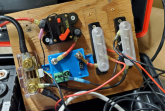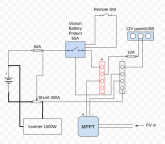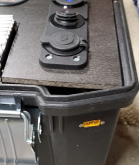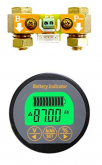atatistcheff
Solar Enthusiast
- Joined
- Sep 20, 2019
- Messages
- 176
Been working on this for a few weeks and it's finally presentable.
Had planned to use an equipment case like a Pelican but couldn't find one in the right dimensions. The tool box was just right, rugged, waterproof and a lot cheaper. Removed the base plate off the inverter to make it fit in the box and replaced with a piece of scrap wood. I don't expect that this will be used enough to build up much heat. But if so, it can always be run with the top open. If needed I can always add a fan to the case but I don't anticipate ever needing to. The inverter has to work pretty hard to heat up enough to even turn on its own fans.
Still need to add a power switch for the remote on the battery protect as well as a power indicator light. For now I can turn it off via bluetooth if it's not being used for an extended time. Even with the MPPT powered it uses about 22mA or less at rest. That's all I can think of for now - enjoy!









- 60Ah LiFePO4 prismatic cells from RUiXU with BMS
- 1500W pure sine wave inverter
- Victron 75/15 MPPT
- Victron 65A smart battery protect
- QC 3.0 USB
- 12V power outlet
- AiLi power meter with 350A shunt
Had planned to use an equipment case like a Pelican but couldn't find one in the right dimensions. The tool box was just right, rugged, waterproof and a lot cheaper. Removed the base plate off the inverter to make it fit in the box and replaced with a piece of scrap wood. I don't expect that this will be used enough to build up much heat. But if so, it can always be run with the top open. If needed I can always add a fan to the case but I don't anticipate ever needing to. The inverter has to work pretty hard to heat up enough to even turn on its own fans.
Still need to add a power switch for the remote on the battery protect as well as a power indicator light. For now I can turn it off via bluetooth if it's not being used for an extended time. Even with the MPPT powered it uses about 22mA or less at rest. That's all I can think of for now - enjoy!









Last edited:





